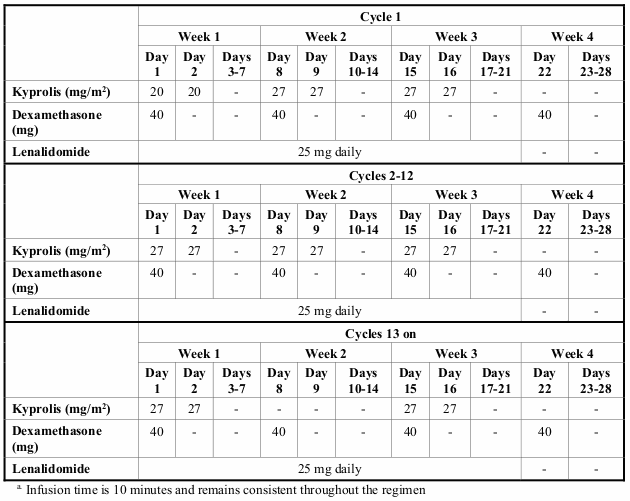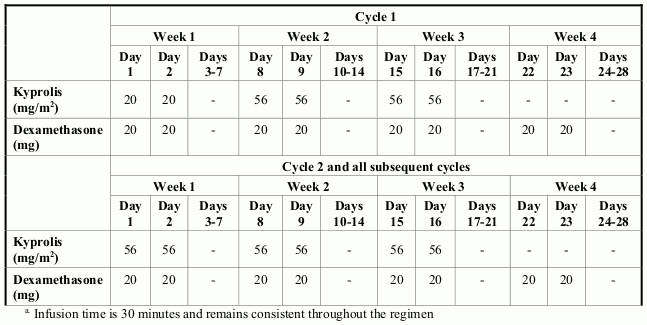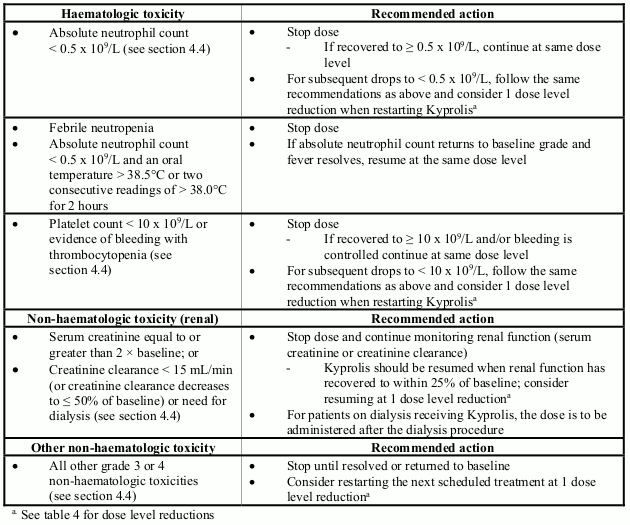Multiple myeloma
Active Ingredient: Carfilzomib
Indication for Carfilzomib
Carfilzomib in combination with either lenalidomide and dexamethasone or dexamethasone alone is indicated for the treatment of adult patients with multiple myeloma who have received at least one prior therapy.
For this indication, competent medicine agencies globally authorize below treatments:
20-56 mg/m² on two consecutive days, each week for three weeks (days 1, 2, 8, 9, 15, and 16)
Route of admnistration
Intravenous
Defined daily dose
20 - 56 mg per m² of body surface area (BSA)
Dosage regimen
From 20 To 56 mg per m² of body surface area (BSA) once every 7 day(s)
Detailed description
The dose is calculated using the patient’s baseline body surface area (BSA). Patients with a BSA greater than 2.2 m² should receive a dose based upon a BSA of 2.2 m². Dose adjustments do not need to be made for weight changes of less than or equal to 20%.
Carfilzomib in combination with lenalidomide and dexamethasone
When combined with lenalidomide and dexamethasone, carfilzomib is administered intravenously as a 10 minute infusion, on two consecutive days, each week for three weeks (days 1, 2, 8, 9, 15, and 16), followed by a 12-day rest period (days 17 to 28) as shown in table 1. Each 28-day period is considered one treatment cycle.
Carfilzomib is administered at a starting dose of 20 mg/m² (maximum dose 44 mg) in cycle 1 on days 1 and 2. If tolerated, the dose should be increased on day 8 of cycle 1 to 27 mg/m² (maximum dose 60 mg). From cycle 13, the day 8 and 9 doses of carfilzomib are omitted.
Treatment may be continued until disease progression or until unacceptable toxicity occurs.
Treatment with carfilzomib combined with lenalidomide and dexamethasone for longer than 18 cycles should be based on an individual benefit/risk assessment, as the data on the tolerability and toxicity of carfilzomib beyond 18 cycles are limited.
In combination with carfilzomib, lenalidomide is administered as 25 mg orally on days 1-21 and dexamethasone is administered as 40 mg orally or intravenously on days 1, 8, 15, and 22 of the 28 day cycles. Appropriate dose reduction for the starting dose of lenalidomide should be considered according to the recommendations in the current lenalidomide summary of product characteristics, for example for patients with baseline renal impairment. Dexamethasone should be administered 30 minutes to 4 hours before carfilzomib.
Table 1. Carfilzomib in combination with lenalidomide and dexamethasonea:
Carfilzomib in combination with dexamethasone
When combined with dexamethasone, carfilzomib is administered intravenously as a 30 minute infusion on two consecutive days, each week for three weeks (days 1, 2, 8, 9, 15, and 16) followed by a 12-day rest period (days 17 to 28) as shown in table 2. Each 28-day period is considered one treatment cycle.
Carfilzomib is administered at a starting dose of 20 mg/m² (maximum dose 44 mg) in cycle 1 on days 1 and 2. If tolerated, the dose should be increased on day 8 of cycle 1 to 56 mg/m² (maximum dose 123 mg).
Treatment may be continued until disease progression or until unacceptable toxicity occurs.
When carfilzomib is combined with dexamethasone alone, dexamethasone is administered as 20 mg orally or intravenously on days 1, 2, 8, 9, 15, 16, 22, and 23 of the 28 day cycles. Dexamethasone should be administered 30 minutes to 4 hours before carfilzomib.
Table 2. Carfilzomib in combination with dexamethasone alonea:
Concomitant medicinal products
Antiviral prophylaxis should be considered in patients being treated with carfilzomib to decrease the risk of herpes zoster reactivation.
Thromboprophylaxis is recommended in patients being treated with carfilzomib in combination with dexamethasone or with lenalidomide and dexamethasone, and should be based on an assessment of the patient’s underlying risks and clinical status.
Hydration, fluid and electrolyte monitoring
Adequate hydration is required before dose administration in cycle 1, especially in patients at high risk of tumour lysis syndrome or renal toxicity. All patients should be monitored for evidence of volume overload and fluid requirements should be tailored to individual patient needs. The total volume of fluids may be adjusted as clinically indicated in patients with baseline cardiac failure or who are at risk for cardiac failure.
Recommended hydration includes both oral fluids (30 mL/kg/day for 48 hours before day 1 of cycle 1) and intravenous fluids (250 mL to 500 mL of appropriate intravenous fluid before each dose in cycle 1). Give an additional 250 mL to 500 mL of intravenous fluids as needed following carfilzomib administration in cycle 1. Oral and/or intravenous hydration should be continued, as needed, in subsequent cycles.
Serum potassium levels should be monitored monthly, or more frequently during treatment with carfilzomib as clinically indicated and will depend on the potassium levels measured before the start of treatment, concomitant therapy used (e.g. medicinal products known to increase the risk of hypokalaemia) and associated comorbidities.
Recommended dose modifications
Dosing should be modified based on carfilzomib toxicity. Recommended actions and dose modifications are presented in table 3. Dose level reductions are presented in table 4.
Table 3. Dose modifications during carfilzomib treatment:
Table 4. Dose level reductions for carfilzomib:
Dosage considerations
Carfilzomib is to be administered by intravenous infusion. The 20/27 mg/m² dose is administered over 10 minutes. The 20/56 mg/m² dose must be administered over 30 minutes.
Liability Disclaimer : RxReasoner has utilized reasonable care in providing content and services that are accurate, complete and up to date. However, RxReasoner does not accept any responsibility or liability about it. The content and services of RxReasoner are for informational purposes only and they are not intended to be a substitute for the knowledge, expertise, skill, and judgment of physicians, pharmacists, nurses, or other healthcare professionals involved in patient care. RxReasoner offers no medical advice. Users are responsible for the use of the provided content. A shown indication or treatment should not be construed to indicate that the medication is safe, appropriate, or effective in any given patient or under any particular circumstances. The absence of an indication or treatment should not roule out the existence of other appropriate medications. Always seek the advice of a physician or other qualified health provider with any questions you may have regarding a medical condition or medicament. RxReasoner is not liable for any damages allegedly sustained arising out of the use of its content and services.



